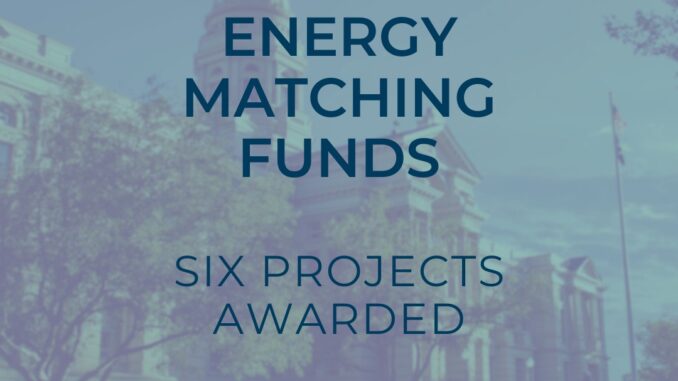
The Wyoming Energy Authority (WEA) announced today that Governor Gordon has approved six separate projects to receive Energy Matching Funds. The total awarding for all six projects is $37,513,104 – leveraging over $120 million in both federal funding and private capital for an investment of over $157 million in Wyoming-based energy projects.
The Wyoming State Legislature appropriated funds to the Office of the Governor in 2022 to leverage Wyoming-based projects that are seeking matching funds for private or federal funding for research, demonstration, pilot projects or commercial deployment projects related to Wyoming energy needs, including but not limited to, carbon capture utilization and storage, carbon dioxide transportation, industrial carbon capture, coal refinery, and hydrogen production, transportation, storage, hydrogen hub development, biomass, biochar, hydropower, lithium, processing and separation, battery storage or wind and solar energy.
“Wyoming continues to show why it is a leader in energy innovation,” Governor Gordon said. “This round of projects — made possible by the Legislature funding the Governor’s Energy Matching Fund — benefits our core industries and sets our sights on new forms of energy development and economic growth. We are successfully leveraging state funds at a greater than one-to-one basis for technologies that create Wyoming jobs and additional investment.”
“The caliber of these six projects shows how Wyoming is truly positioned to be a trailblazer for the future of the energy industry,” said Rob Creager, Executive Director of the WEA. “Not only do these companies want to work with our state’s incredible natural resources, but they want to work with our communities and experienced workforce. Each of these projects uses a valuable Wyoming resource and, through ingenuity and effort, works to create a future where Wyoming-made energy is very much still front and center of the market.”
Black Hills Energy (BHE) and Babcock & Wilcox (B&W) have been awarded $15,995,451 – in two phases of funding – for their project that converts coal from the WyoDak mine into low-carbon hydrogen and single-stream CO2. With the award, BHE and B&W will complete the planning and design package for a facility that will demonstrate the groundbreaking chemical looping process, BrightLoop, to produce fifteen metric tons of hydrogen a day. If the phase that is designed with this grant is constructed and is successful, the final completed project would serve as the foundation for expanded hydrogen production using Powder River Basin coal, not only from the WyoDak mine but from other sites across Wyoming, creating new value streams for one of Wyoming’s legacy resources.
“Black Hills Energy is proud to continue to be a part of Wyoming’s all-of-the-above energy strategy,” said Mark Lux, Vice President of Power Delivery for Black Hills Energy. “Support of innovation from the State of Wyoming and Wyoming Energy Authority sets the tone for an exciting energy future for Wyoming.”
The WEA previously awarded BHE and B&W a grant for a feasibility study for the BrightLoop technology. “We’re excited that this important project is advancing to the next phase, and we thank the State of Wyoming and the Wyoming Energy Authority for supporting these efforts as we work with our partner, Black Hills Energy, to advance Wyoming’s clean energy future,” said Babcock & Wilcox Chief Technology Officer, Brandy Johnson.
Cowboy Clean Fuels received $7,792,653 in funding for their “Triangle Unit Carbon Capture and Storage Project.” The company is an early-stage clean energy and climate tech company with offices in Gillette, Wyoming, and Denver, Colorado. Established to commercialize technology developed at the University of Wyoming, Cowboy Clean Fuels uses biomass as feedstock for low-carbon renewable natural gas. The project, which uses the byproducts of sugar beet refining as feedstock injection, dilutes the byproducts unavailable for human consumption and injects them into deep coalbed methane wells and related nonproductive natural gas infrastructure. The feedstock is naturally converted into CO2, which gets permanently sequestered by hydrostatic pressures, and methane, which can be brought to the surface and then to market. This project has potential for both Wyoming’s energy and agricultural industries.
“Cowboy is thrilled to be building its first commercial renewable natural gas and carbon sequestration project in the Powder River Basin,” said Ryan Waddington, Co-Founder and CEO. “The Triangle Unit Project represents the culmination of years of research and development at the University of Wyoming, and we appreciate the support from the Wyoming Energy Authority to help make the project a reality.”
Casper, Wyoming-based Flowstate Solutions received $2 million in funding for their project, “CO2 and Hydrogen Pipeline Safety: AI-Driven Leak Detection,” which addresses leak detection failures in Wyoming’s oil and gas operations, hydrogen transportation, and carbon capture and sequestration efforts. Using an innovative AI-driven leak detection solution, Flowstate’s all-Wyoming team aims to enhance pipeline transport safety and efficiency for Wyoming’s core energy sectors. By providing advanced leak detection for CO2 pipelines (captured from coal plants and used in EOR activities) and natural gas, the technology ensures fewer disruptions, reduces product loss and revenue impacts, and helps companies comply with regulations.
“Leak detection for these pipelines is a looming problem that has been a challenge in the industry for various reasons,” said Jerad Stack, CEO of Flowstate. “We are at a point where technology is emerging that can provide a needed breakthrough. However, extending this technology will require research investment. These funds provide the stimulus necessary to surmount some of those challenges and, in doing so, ensure that this critical infrastructure is operated in a way that is safe for our citizens and our environment.”
Membrane Technology and Research, Inc. (MTR) received $8 million in funding for their Large Pilot Project at Basin Electric’s Dry Fork Station in Gillette, Wyoming. In this project, MTR is advancing its innovative membrane-based post-combustion carbon capture process through the final pre-commercial stage of development. The goal of this project, which is partially funded by the Department of Energy, is to design, build, and operate a 150-tonne-per-day large pilot CO2 capture system at the Wyoming Integrated Test Center (WITC) using a 10-megawatt-electric (MWe) equivalent slipstream of flue gas from an active coal power plant, achieve a greater than a 90% CO2 capture rate, and produce pipeline quality CO2.
The successful operation of MTR’s Large Pilot will validate this innovative carbon capture approach. It is also an integral step for another MTR project at Dry Fork Station recently awarded by the DOE Office of Clean Energy Demonstration (OCED) that covers Phase I of a full-scale, integrated carbon capture and storage program. This overall effort will position Dry Fork Station as a low-carbon-emitting, base-loaded generation asset well into the future, showcasing a successful and affordable capture option for industries utilizing Wyoming coal.
“MTR’s Large Pilot capture plant represents the culmination of a fifteen-year federal program to develop innovative, second-generation capture technologies. This award supports the construction and operation of MTR’s membrane-based capture plant at the Wyoming Integrated Test Center, where it will be the largest capture plant of its kind when commissioned next year,” said Brett Andrews, President of MTR Carbon Capture. “Without question, the Wyoming ITC is the best place for MTR to demonstrate our capture process to the world. Wyoming leads the way for decarbonization. We look forward to showcasing the effective, robust and economic capture of CO2 from Powder River Basin coal-derived flue gas, and we thank the WEA for this award and for their continued support.”
The University of Wyoming School of Energy Resources (SER) was awarded $2,750,000 in funding for their pilot project that tackles the large quantities of water produced by oil and gas wells by adequately treating it so it can be used for generating hydrogen.
Steam methane reforming is a well-established technology to produce hydrogen, requiring methane and clean water. The team from SER will design, build, demonstrate and field-test a supercritical water desalination and oxidation unit, integrated with steam methane reforming functionality, to ultimately produce one ton of hydrogen a day using produced water at a cost of around 15% below existing methods.
The technology will be designed at the University of Wyoming and Los Alamos National Labs in Santa Fe, NM, manufactured in Cheyenne, and deployed at the Williams Echo Springs gas plant in Wamsutter. After completion of the award, the University of Wyoming will own the containerized pilot and use it to facilitate other awards and provide demonstrations and outreach to companies and communities interested in the hydrogen economy.
“We were able to earn selection for the award from the Department of Energy thanks to the state support through the Energy Matching Funds,” says Charles Nye, Research Scientist at SER and Co-Principal of the project. “The EMF model is an excellent example of the important partnership between state, federal, non-profit, and private entities to advance compelling research projects in Wyoming that address critical energy needs.”
For an independent but complimentary project to the SER pilot project above, Williams Companies received $975,000 for their feasibility study to assess the development of a saline CO2 storage hub, also located at their Echo Springs gas plant in Wamsutter. The Echo Springs CarbonSAFE Storage Complex Feasibility Study aims to prove the ability to sequester CO2 safely in the region’s geological formations by drilling a stratigraphic test well and high-quality model and developing all foundational documents for a Class VI permit to enable further development of the site.
Williams, an experienced midstream natural gas company with expansive operations in southern Wyoming, is partnering with the University of Wyoming School of Energy Resources on this project. The project has the potential to extend the economic viability of the Echo Springs gas plant and encourage other industry development in the region, which can also capitalize on CO2 storage.
“Williams is proud to be a part of this study, which is the critical next step toward the development of a commercial-scale carbon capture and storage complex adjacent to our natural gas processing assets in southern Wyoming,” said Williams Vice President of New Energy Ventures Brian Hlavinka. “I’m optimistic about the outcome of this project and appreciate the ongoing partnership and support from the University of Wyoming’s research team and the state of Wyoming.”
